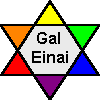Kabbalah and Medicine
The Colors of the Eye - Part 1 In Kabbalah we are taught that the eye is a miniature mirror that reflects the entire man as created in the image of God, both body and soul. The eye possesses four colors that correspond both to the four letters of God's essential Name Havayah, as well as to the four legs of the Divine throne and chariot. The white of the eye reflects the yud of the Name Havayah and corresponds to the power of wisdom--Divine insight--and its emotive derivative (along the right axis of the sefirotic tree of life), the power of lovingkindness. These are the spiritual attributes of our first forefather, Abraham. Around and penetrating into the white "sea" (of wisdom) of the eye are tiny but visible red blood vessels. In Jacob's blessing to his son Judah, he blesses his eyes to become red from good wine. From this we understand that wine--which itself is red and is even referred to in the Torah as the "blood of grapes"--brings out the red in the eyes. The red in the eyes reflects the hei of the Name Havayah and corresponds to the power of understanding (the left intellectual power)--the ability of the soul to meditate on the Divine (the spiritual service referred to in the Torah, metaphorically, as "drinking wine")--and its emotive derivative, the power of might (together with its inner property, the power of awe). These are the spiritual attributes of our second forefather, Isaac. In general, when we speak of the color of the eye--which distinguishes one individual from another--we refer to the color of the iris. Here, one is either blue-eyed, brown-eyed, or green-eyed, with various shades in between. In the terminology of the Torah, all of these colors are considered to be shades of a general color referred to as "yellow-green" (yarok). The particular color of each individual's eyes reflects the vav of the Name Havayah and corresponds to the central power of the mind, knowledge (da'at). Our sages teach that it is each individual's da'at that distinguishes his personality from another's: "Just as each individual's face is unlike another's, so is each individual's da'at unlike another's." Here, the particular color of the eye varies from individual to individual. Daíat is referred to as the "key" that opens all of the chambers of the heart, the six emotive powers from chesed ("lovingkindness") to yesod ("truth," "faithfulness," and "devotion"). These in turn correspond to the full spectrum of the colors of the rainbow. With respect to the particular colors of the eye, the various shades of blue correspond to the heartís right axis, chesed ("lovingkindness") and netzach ("victory," "confidence"); the various shades of brown correspond to the heartís left axis, gevurah ("might," "awe") and hod ("thanksgiving," "glory"); the various shades of yellow-green correspond to the heart's middle axis, tiferet ("beauty," "mercy") and yesod. Though da'at opens all the chambers of the heart, its major derivative--its primary manifestation in the emotions--is the power of tiferet (yellow) and the latter's immediate and direct derivative, the power of yesod (green). Yellow is the color of the sun and green is the color of vegetation nourished by the sun's light rays (by the process of photosynthesis). We thus understand why, in the terminology of the Torah, yellow-green is chosen to represent the all-inclusive color (whose shades vary from person to person). Tiferet means "beauty," defined in Kabbalah and Chassidut to be the harmonious blending of many colors together. The beauty of the eye is in its individual color, which in a certain sense reflects or suggests the full spectrum of the rainbow. The spiritual attributes corresponding to the eye's individual color, da'at and tiferet, are those of our third forefather, Jacob. Of Jacob it is said that "his bed is complete," with twelve holy sons, the progenitors of the twelve tribes of Israel. Each tribe possessed its own color, the color of its precious stone in the breastplate of the high priest and that displayed on its flag (which marked its campsite in the desert). Finally, we come to the pupil of the eye, whose color --or better, absence of color--is black. The pupil of the eye is referred to in the Torah as the "daughter" of the eye. In Kabbalah the "daughter" figure is always associated with the power of malchut ("kingdom"), the last of the sefirot, which, "possessing nothing of its own" (only that which it receives from above), corresponds to black (the experience of existential lowliness and distance from God, the inner property of malchut). This is the property of King David, who said, "and I shall [always] be lowly in my own eyes," most clearly alluding to the intrinsic state of lowliness within the eye, its black pupil. The power of sight emanates from the inner point of the pupil of the eye. As in the beginning of creation, light shines out of the darkness--"darkness precedes light." The prophet states, "from afar God appears to me," from the innermost point of the existential state of feeling "afar" from God (the inner point of the pupil) does God's light shine to the eyes of man. A new chapter is both uploaded to the web and sent out every week via the Inner Dimension (free) weekly Torah message email list. Click here to subscribe now!
|
